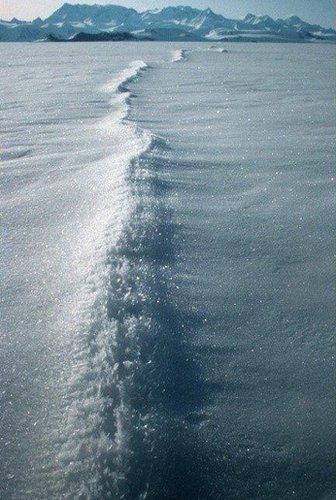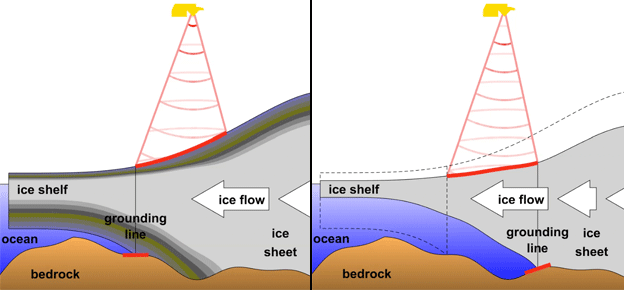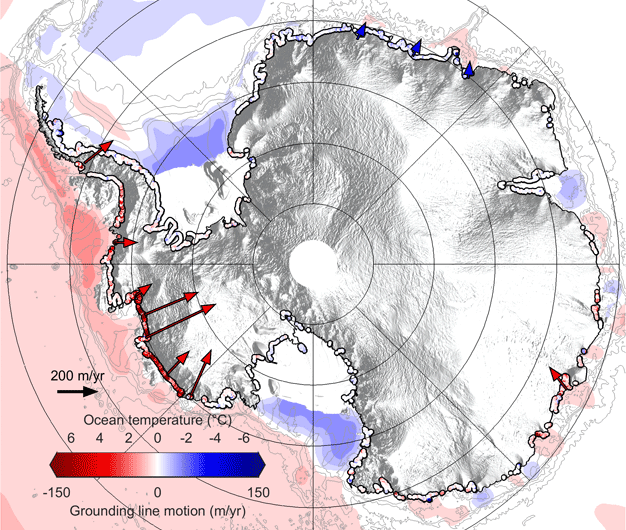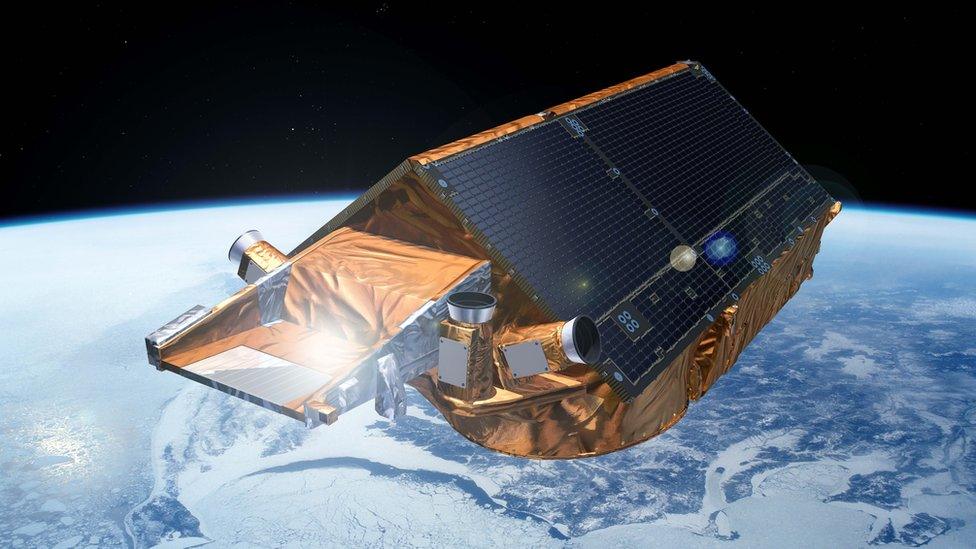Antarctica 'gives ground to the ocean'
- Published

A photo of the surface expression of the grounding line on Antarctica's Rutford ice stream. The position is not always so obvious
Scientists now have their best view yet of where Antarctica is giving up ground to the ocean as some of its biggest glaciers are eaten away from below by warm water.
Researchers using Europe's Cryosat radar spacecraft have traced the movement of grounding lines around the continent.
These are the places where the fronts of glaciers that flow from the land into the ocean start to lift and float.
The new study reveals an area of seafloor the size of Greater London that was previously in contact with ice is now free of it.
"What we're able to do now with Cryosat is put the behaviour of retreating glaciers in a much wider context," said Dr Hannes Konrad from the University of Leeds, UK.
"Our method for monitoring grounding lines requires a lot of data but it means you could now basically build a permanent service to monitor the state of the edges of the continent," he told BBC News.

What Cryosat sees: As the grounding line retreats, the elevation of the ice above lowers
Although the end product is quite simple, the process of getting to it is quite a complex one.
Viewed from above, the position of grounding lines is not always obvious.
The glaciers themselves are hundreds of metres thick, and where they begin to float as they come off the continent can be hard to discern in simple satellite images.
But there are radar techniques that can find their location by spotting the up and down tidal movement of a glacier's floating ice. This, however, is just a snapshot in time.
What Dr Konrad and colleagues have done is use these known positions and then combine the data with knowledge about the shape of the underlying rock bed and changes in the height of the glaciers' surface to track the evolving status of the grounding lines through time.
The new study triples the coverage of previous surveys.

The study confirms general trends but with a much wider and more detailed context
On the face of it, the results are pretty much as expected.
Of the 1,463km² of grounded ice that has been given up, most of it is in well documented areas of West Antarctica where warm ocean water is known to be infiltrating the undersides of glaciers to melt them.
Dr Konrad explained: "If you take 25m per year as a threshold, which is sort of the average since the end of the last ice age, and you say anything below this threshold is normal behaviour and anything above it is faster than normal - then in West Antarctica, almost 22% of grounding lines are retreating more rapidly than 25m/yr.
"That's a statement we can only make now because we have this wider context."
The new data-set confirms other observations that show the mighty Pine Island Glacier, one of the biggest and fast-flowing glaciers on Earth, and whose grounding line had been in major retreat since the 1940s, appears now to have stabilised somewhat.
The line is currently going backwards by only 40m/yr compared with the roughly 1,000m/yr seen in previous studies. This could suggest that ocean melting at the PIG's base is pausing.
Its next-door neighbour, Thwaites Glacier, on the other hand, is seeing an acceleration in the reversal of its grounding line - from 340m/yr to 420m/yr.
Thwaites is now the glacier of concern because of its potential large contribution to global sea-level rise. And the UK and American authorities will shortly announce a major joint campaign to go and study this ice stream in detail.

Artwork: Cryosat, with its radar altimeter instrument, was launched to orbit in 2010
Elsewhere on the continent, 10% of marine-terminating glaciers around the Antarctic Peninsula are above the 25m/yr threshold; whereas in East Antarctic, only 3% are.
The significant stand-out in the East is Totten Glacier, whose grounding line is retreating at a rate of 154m/yr.
Overall, for the entire continent, 10.7% of the grounding line retreated faster than 25m/yr, while 1.9% advanced faster than the threshold.
One fascinating number to come out of the study is that grounding lines in general are seen to retreat 110m for every metre of thinning on the fastest flowing glaciers. This relationship will constrain computer models that try to simulate future change on the continent.
Leeds co-author Dr Anna Hogg said: "The big improvement here is Cryosat, which gives us continuous, continent-wide coverage, which we simply didn't have with previous radar missions.
"Its capabilities have allowed us to build up a picture of retreat rates, especially at the steeply sloping margins of the continent, which is where these changes are taking place. We have eight years of coverage now and it's guaranteed in the future for as long as Cryosat keeps working," she told BBC News.
Since conducting the study at Leeds, Dr Konrad has now moved to the Alfred Wegener Institute in Bremerhaven, Germany.
Jonathan.Amos-INTERNET@bbc.co.uk, external and follow me on Twitter: @BBCAmos, external